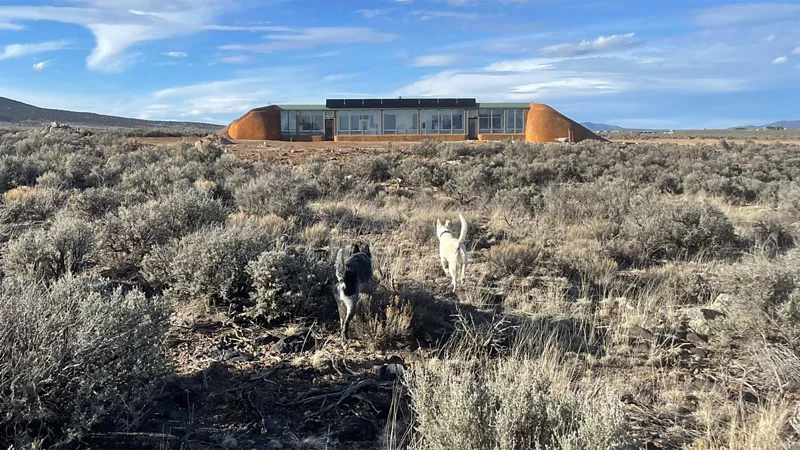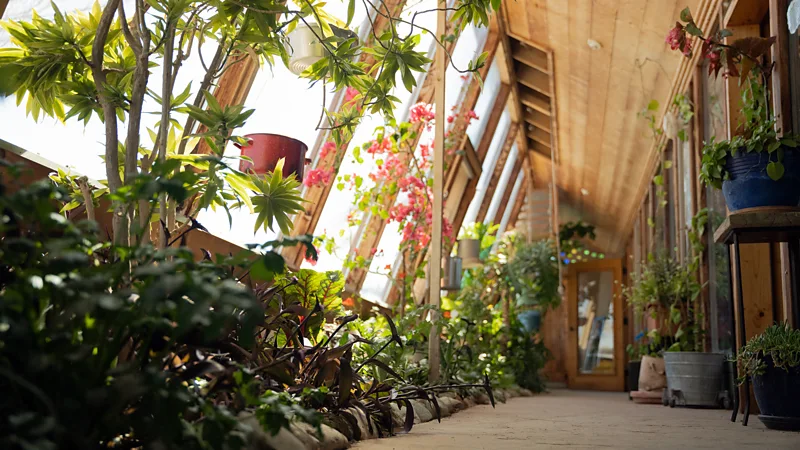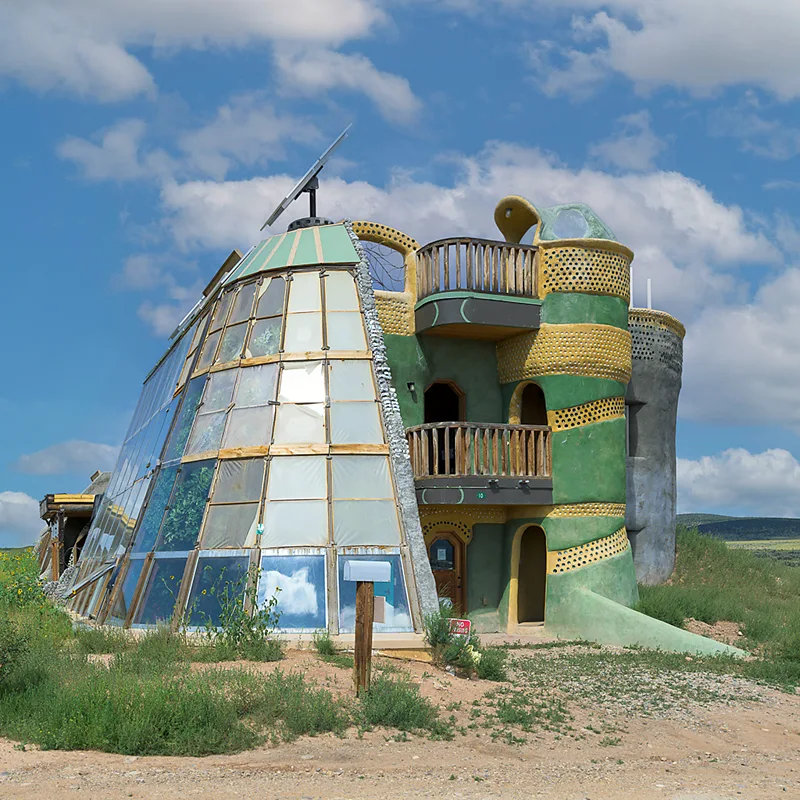Introduction to Earthship Homes:
Nestled in the high desert of New Mexico, Earthships are a revolutionary concept in eco-friendly living. These unconventional homes, designed to thrive in extreme desert conditions, range from palatial to sculptural, blending modern and ancient architecture. Located around the town of Taos, these homes have become a symbol of sustainable living, with their designs often resembling structures from a science fiction movie. Earthship Homes are not just aesthetically striking but also have a profound environmental significance, as they are built using a combination of natural and waste materials like old tires, wine bottles, and mud.
What are Earthships?
Earthships are net-zero, eco-friendly homes that aim to reduce the carbon footprint associated with traditional construction methods. They were invented around 40 years ago in Taos, New Mexico, by eco-architect Michael Reynolds. These homes are constructed from both natural materials and recyclable waste like used tires, empty bottles, and scrap wood. Earthships require fewer toxic or carbon-emitting materials like concrete and plastics, making them a more sustainable option for home construction. The goal of these homes is to rely on renewable resources for energy, water, and food production, reducing the reliance on natural resources like wood.

The Rising Demand for Earthships
As the demand for sustainable living options increases, Earthships have gained traction globally. With prices ranging from $500,000 to $900,000, they are also available for short-term stays around Taos, allowing visitors to experience life off the grid. The nightly rates for an Earthship stay average around $240, giving people a taste of this innovative, self-sufficient lifestyle.
Origins of Earthships: Michael Reynolds’ Vision
The Earthship movement was spearheaded by Michael Reynolds, a native of Kentucky, who moved to Taos in 1969 with a degree in architecture. Reynolds initially had no plans to start an eco-movement but sought a lifestyle of adventure. However, a moment of clarity occurred when he learned about environmental degradation, especially the destruction of forests for timber and the associated environmental damage, such as soil erosion and oxygen loss.
Reynolds’ inspiration came from seeing discarded beer cans strewn across the landscape. He asked himself, “Why not build homes out of these cans instead of cutting down trees?” This simple idea laid the foundation for his first beer-can house, built in 1971. Although initially dismissed as eccentric, the house garnered international attention, with exhibits in prominent institutions like the Louvre Museum in Paris and the Museum of Modern Art (MoMA) in New York City. MoMA even purchased a beer-can brick for its permanent collection.
Overcoming Criticism and Building a Legacy in Earthship Homes
Despite his success, Reynolds faced criticism for his unconventional building methods. Many saw his ideas as impractical and whimsical. Yet, Reynolds persisted. He started using other materials like bottles and tires and, over time, developed a blueprint for what would become Earthships. It took over 30 years for Earthships to gain widespread acceptance, but today they are recognized as a viable solution for sustainable, off-grid living.

Earthships: A Solution to the Housing Crisis and Climate Change
Earthships offer a unique solution to two of the most pressing global issues: the housing crisis and climate change. Their sustainable design makes them particularly appealing to those looking to reduce their utility bills and live independently from conventional energy grids. Earthships are designed to be entirely off-grid, relying on solar power, wind turbines, and other renewable energy sources. This allows residents to avoid the rising costs of electricity and utility bills, offering a financially empowering lifestyle.
Living in an Earthship: What’s It Like?
Taos, known for its artistic and individualistic culture, was the perfect setting for the Earthship movement. The region’s traditional adobe homes and extreme weather conditions—cold, snowy winters and dry, hot summers—presented the ideal environment to test Earthship designs. Earthships are built with thick, insulated walls made from tires packed with earth, surrounded by an earth berm for natural temperature regulation. These homes are designed to maintain an internal temperature of around 72°F (21°C) year-round, regardless of the outside weather.
Each Earthship includes a greenhouse, which allows residents to grow their own food, further promoting self-sufficiency. These homes are primarily powered by solar energy, with some incorporating wind turbines or wood-burning stoves as backup energy sources.
A Personal Experience: Life Inside an Earthship
Michael Reynolds himself moved into his first Earthship 35 years ago and raised his family there. He still lives in the home and describes it as incredibly comfortable. Earthship residents often describe the experience as being enveloped in warmth and comfort, as if living inside a “womb,” due to the stable, regulated temperatures inside the home.
Deborah Binder, Earthship construction manager, attests to the comfort of living in an Earthship. She moved to Taos 11 years ago to manage a non-profit project in Malawi, Africa, and stayed with the company, even renting an Earthship while building her own. Binder now teaches at the Earthship Academy, where individuals from around the world come to learn about Earthship design and construction.
The Future of Earthships: A Solution for Homelessness and Poverty
Despite their environmental benefits, Earthships have yet to gain mainstream acceptance as a viable solution to the housing crisis. Many people still view them as fringe or alternative housing options. However, Reynolds believes that Earthships have the potential to address homelessness and energy poverty. His latest model, the Refuge Earthship, is a more economical version of the traditional Earthship, designed to be replicated globally.
Reynolds’ vision extends beyond individual homes. He aims to create Earthship communities where people can live sustainably without the burden of high utility bills. His goal is to build affordable, off-grid housing that can be rented at fair prices, offering a practical solution for those facing homelessness or economic hardship.

The Artistic Side in Earthship Homes
Earthships are not only functional but also artistic. Reynolds, who put himself through college by working as an artist, incorporates sculptural and stained-glass elements into the homes. The whimsical, artistic design of some Earthships, like the curvy turquoise Atlantis model, demonstrates the creativity behind these homes. Reynolds believes that Earthships are more than just sustainable homes—they are works of art that care for both people and the planet.
Conclusion: Earthships as the Future of Sustainable Living
Earthships represent a unique blend of sustainability, self-sufficiency, and artistry. As the world faces growing environmental challenges, the need for innovative housing solutions like Earthships has never been more urgent. By reducing reliance on natural resources and eliminating utility bills, Earthships offer a financially viable and environmentally friendly alternative to traditional homes. As more people experience the comfort and practicality of living in an Earthship, the movement is likely to continue gaining momentum, providing a path forward for sustainable living.










